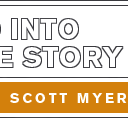Screenwriting Mantra: Minimum Words, Maximum Impact
The origin and importance of one of the best screenwriting mantras… ever!
I know the source of this mantra. It was one of my online screenwriting students. During a weekly live-chat session. I was going on and on about the importance of writing tight, taut, lean scene description, make it easy on the eye, clean on the page, really getting on my bully pulpit. Then a student typed:
Minimum words, maximum impact?
Here I had been guilty of the very thing I was decrying, then — boom! The perfect comment. Four words. And maximum impact indeed!
Screenplays are a unique form. Unlike novels which can be hundreds, even thousands of pages long, a feature length script is typically no longer than 120 pages, even less nowadays with action, comedy, and horror scripts clocking in at 90–95 pages. Simply based on the fact that you have a limit to the page count means you should be mindful of how you approach your use of words when handling scene description.
Beyond that, there is an aesthetic consideration. Scripts filled with black ink are not only less pleasant to look at, they’re harder for a reader to get through. White space is more attractive to the eye, which can have a psychological effect on a reader, and can make a script a better read. In truth, I’ve known some script readers who have told me they hate reading scene description and often will skip big blocks of it to read the dialogue. Why? Because dialogue margins are narrower and therefore easier to read.
But there’s an even more important reason why we need to be incredibly choosy about the words we use when writing scene description: To make an impact on the reader. How do we do that? Strong verbs. Visual nouns and adjectives. Tight paragraphs. Good, lean imagematic writing. Here’s an example from the beginning of The Matrix:
18 lines and a ton of action. Average paragraph length: 2 lines. And note those descriptors: flicks, inhumanly fast, blinks, snaps, explodes, erupting, kicks, wrecking ball, flies, limp meat and bone, slams, raking, sweeping, leather-clad ghost, snatched, twisted, fired, gunfire. You could almost just read those key words and get a sense of the action.
Of course, the mantra pertains to dialogue as well. I’ve heard an anecdote about one of the first things Clint Eastwood does when he agrees to act in a movie is take a red marker and cross out half of his dialogue. Movies are primarily a visual medium. While important, creating moments where with a minimum of dialogue we let the emotion of the scene work its magic in subtext and silence is most often the preferred way to go.
File this one under “less is more.”
Minimum words, maximum impact.
For other Screenwriting Mantras, go here.
